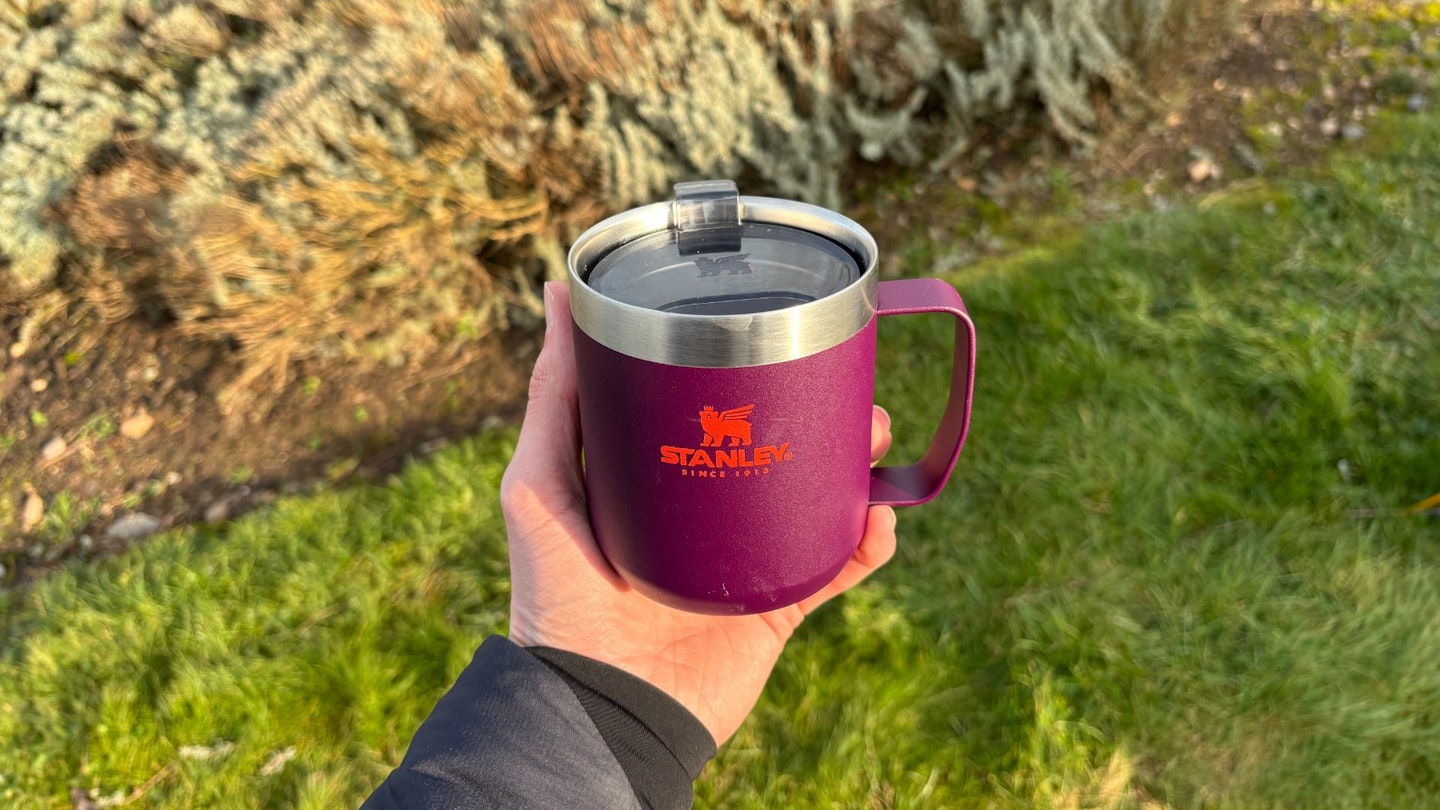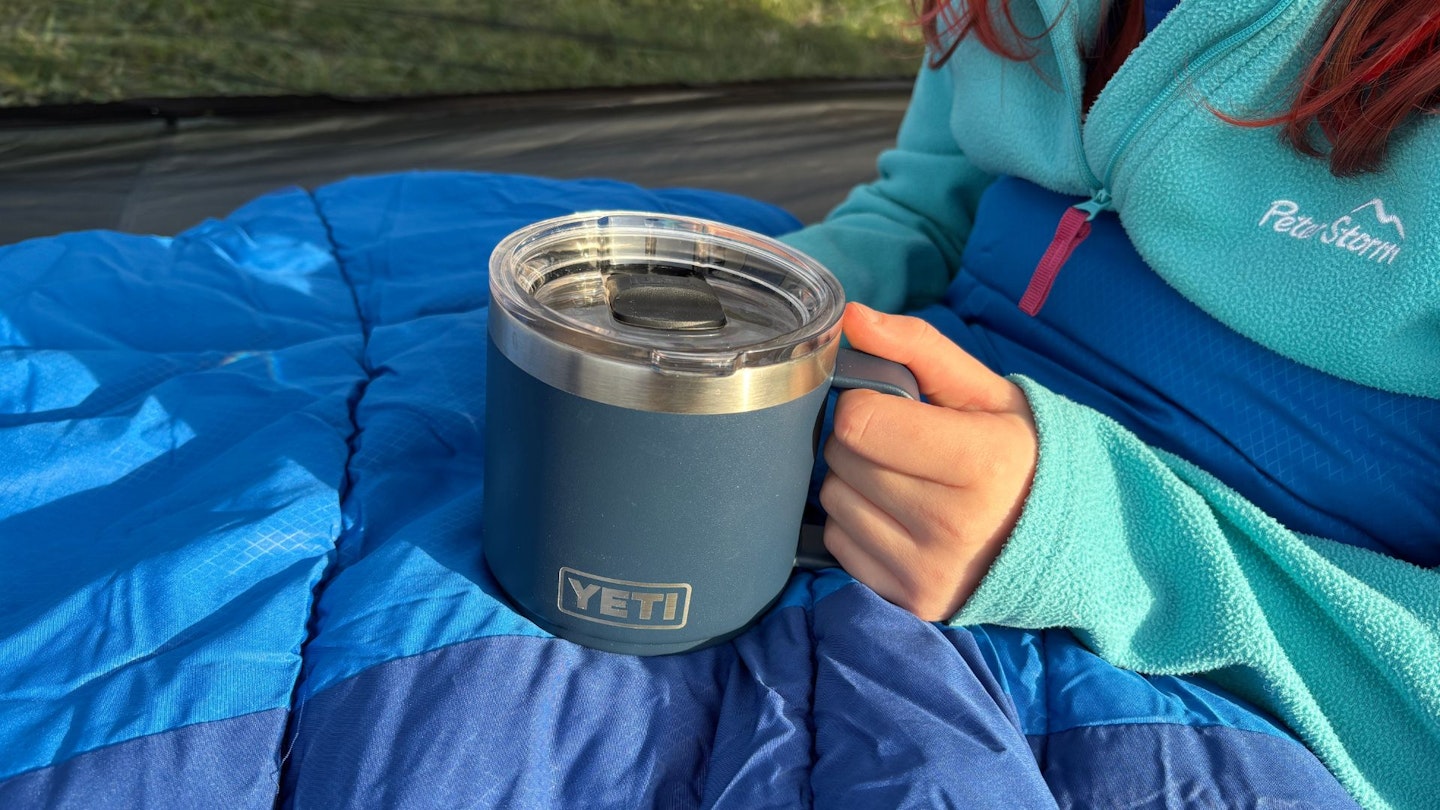What's your favourite smell in the morning when camping? Bacon sizzling away on the camping stove? The wilderness? Coffee? If it's that last one (other hot drinks are available) then you're going to need something decent to drink it from. That's why we've put together this test of the best camping mugs.
Hot drinks are a key part of all camping trips. If you're wild camping above the tree line they're key to warming up before bed or taking the chill away as the sun rises.
Alternatively, if you're car camping they can be an absolute must while lounging around the family tent in the evening (hot chocolate, anyone?).
The thing is, as much as everyone's favourite hot drink varies, so does the types of camping mugs available. But that's good news, seeing as though one person's needs are different to another's.
What you'll find below is an in-depth test of a range of different options that'll suit a mix of scenarios. Below the reviews, you'll also find a buying guide to camping mugs, which explains what you need to consider when purchasing. Plus, there are a few words on how we tested.
Best camping mugs at a glance
Best in test: Lifeventure Insulated Mountain Mug
Highly recommended: CamelBak Thrive Vacuum Insulated Stainless Steel Mug 500ml
Best for backpacking: GSI Infinity Backpacker Mug
How we tested
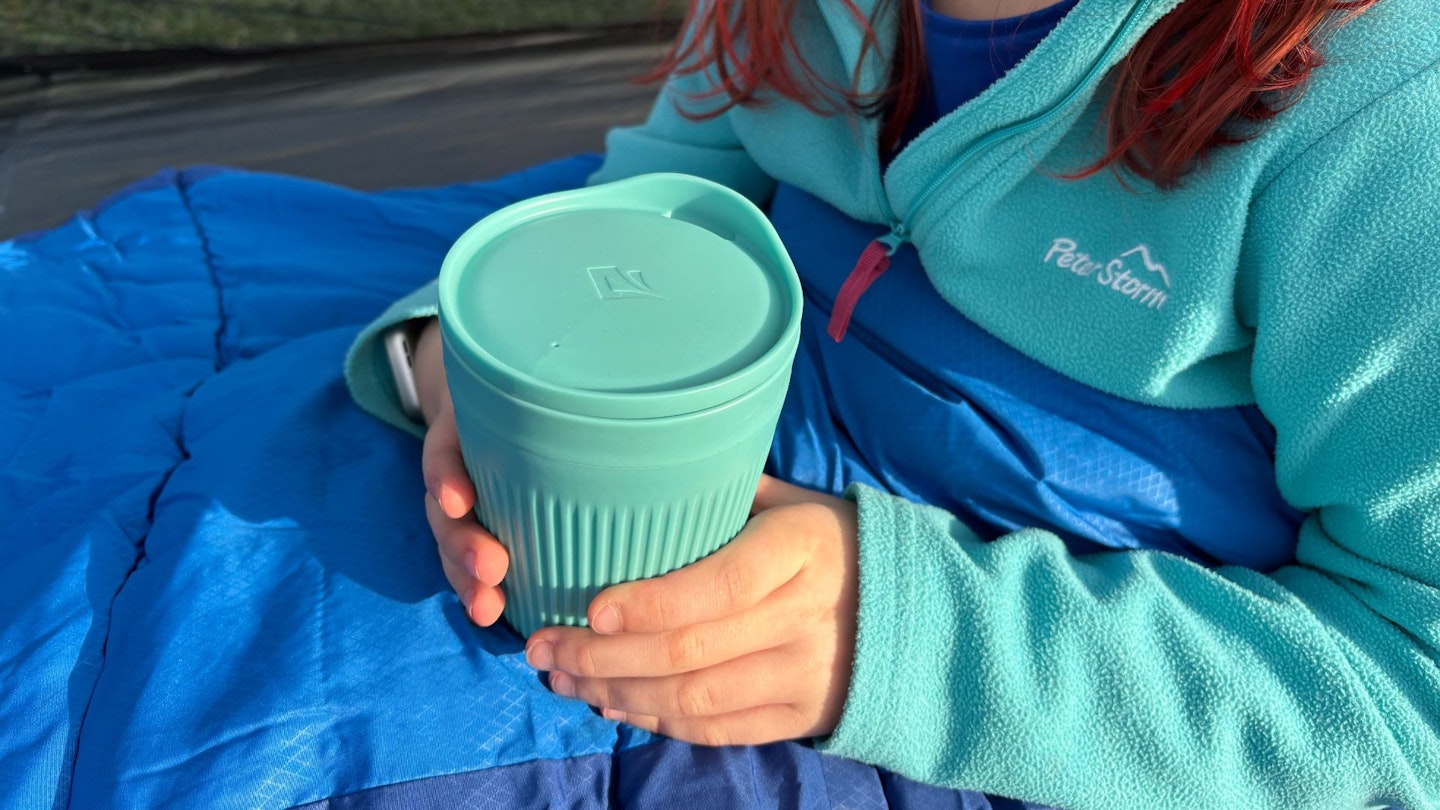
All of these camping mugs have been used thoroughly by LFTO deputy editor Rob Slade and his family. They’ve been tested on walks, in day-to-day life and while sitting around the tent.
On top of the general usage, we’ve also conducted a couple of controlled tests to judge these mugs’ thermal properties beyond our anecdotal evidence.
The first one we conducted was on how well these camping mugs kept things cool. We did this by dropping two ice cubes of the same size into each mug and leaving them in the same place at the same time to see how long they took to melt.
Vitally, we also conducted a controlled test to see how long fluids stay warm inside each mug. To do this, we poured 200ml of boiling water into each mug, fitted the lids and left them all in the same place at the same time. For this test, we left them outside so we could account for the impact that any chilly winds might have on the drinks’ temperatures.
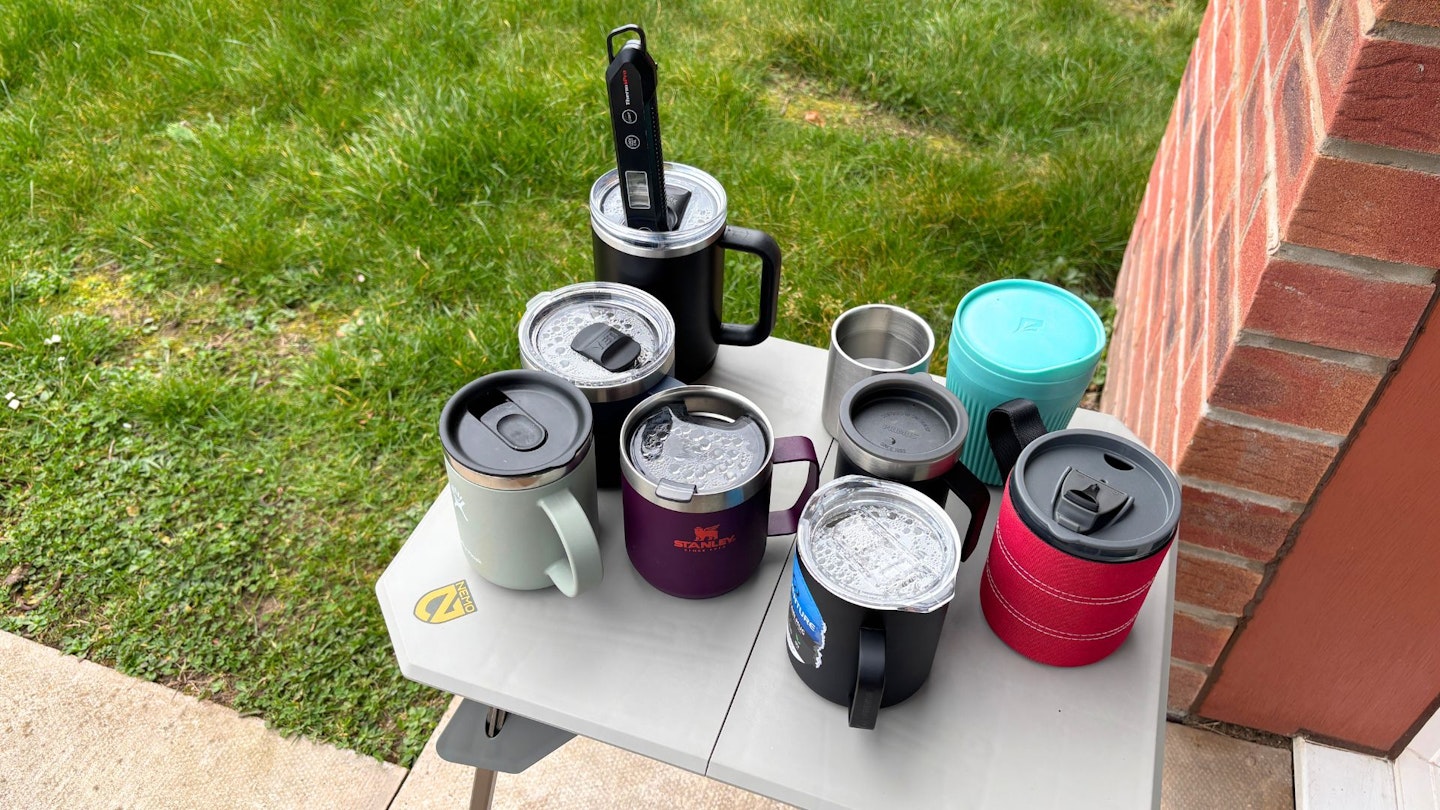
We then checked the temperature of each drink every 10 minutes with a thermometer to determine which ones stayed warmest the longest.
Aside from that, we also filled the mugs up and held them upside down and on their side for a set amount of time to determine how leak-proof they were.
Each mug has then been scored against a set criteria, which was: performance, weight, ease of use, ease of cleaning and value for money.
For more info on how we review, see our how we test page.
Best camping mugs in 2025
Let’s start by saying that this affordable mug is full of surprises. The first of which is that this is one of the lightest double-walled mugs on test, coming in at a decent 258g with a 350ml capacity.
The second surprise, considering this mug is half the price of several others featured here, was the thermal performance. The Lifeventure Insulated Mountain Mug finished our two-hour test with a water temperature of 41°C – the best of the lot.
Measurements across the testing period read as follows: 74°C after 10 minutes, 65°C after 30 minutes, 53°C after an hour and finally 41°C after two.
It was also the third-best mug at keeping ice cubes cool in our cold test, with 12g of ice left over after three hours.
The handle is a little thin and not the most ergonomic or comfortable, while the mug itself isn’t the thickest, so of all the metal mugs on test this is the one that I’d be most worried about in terms of durability. I had no issues during a couple of months of testing, though.
The opening in the lid allows for a solid and controllable flow rate and when the plastic tab is slid across it helps prevent splashes. Tip it on its side, though, and water will start to dribble out.
Cleaning is similar to other lids with a sliding opening. Lifesystems don’t declare it dishwasher safe, so I’d recommend sticking to handwashing.
Luckily, the sliding mechanism can clip off to enable you to give it a proper clean, though the plastic tabs that clip it into place look like a potential weak point in the durability stakes. There've been no issues to date, though.
The rubber seal around the lid also has more movement than the other lids on test, so this could be a potential weak point in future.
Overall though, the price, light weight and thermal performance make this a really solid performer, as long as you’re not after a more ‘trendy’ brand name.
Pros
- Impressively light
- Excellent heat retention
- Great value
- Easy to clean
Cons
- Potential question around durability
| RRP: | £15.99 |
| Weight: | 258g / 9.1oz |
| Material: | Double-walled stainless steel |
| Volume: | 350ml / 11.8oz |
| Dishwasher safe? | Not stated |
The CamelBak Thrive mug stands out in this test as it’s got the biggest capacity – a whopping 500ml – and is also the only one with a truly leakproof lid. Unlike all the others on test, the lid screws in, rather than just pushes in place.
That’s a great feature, but it’s not the only thing I love about the lid. It’s easy to drink from, with a decent, steady flow of liquid. But even more pleasing is the fact the the sliding mechanism over the opening can actually be taken apart for cleaning.
Add the fact that this camping mug is also dishwasher-safe and you get a winning combination of easy cleaning.
I was also a fan of the soft handle, which is comfortable to hold and gives a sturdy, stable purchase on a full mug (it appears to be replaceable, too, as it can be unscrewed). You also get a ‘protective bumper’ on the bottom of the mug to offer greater grip and durability.
Perhaps unsurprisingly given the heft of this camping mug, the Thrive is a big hitter on the thermal stakes. Temperature readings showed 70°C after 10 minutes, 62°C after 30 minutes, 51°C after an hour and 40°C after two hours.
Those results place it as the second-best camping mug for keeping your drink warm. Admittedly, the speed of drop-off was very similar to the winner, it’s just the Lifesystems mug finished up 1°C warmer after two hours.
Meanwhile, the CamelBak proved the winner of our ice cube test, with 20g of ice left in the mug after three hours.
Given the increased size, it was a slight surprise that this one isn’t the heaviest in test, but it’s not far behind. Its weight of 412g puts it second, but if you stick 500ml of tea in it then you’re going to be looking at a weight that’s not far below a kilogram, so that’s something to be aware of.
If that doesn’t bother you, though, and you’re happy to pay a premium for it, then this is easily one of the best camping mugs around. It’s only edged out by the Lifesystems mug because of the difference in price and weight.
Pros
- Easy to clean
- Great thermal performance
- Leakproof lid
- Sturdy and grippy
Cons
- One of the heavier options
- Expensive
| RRP: | £35 |
| Weight: | |
| Material: | |
| Volume: |
Here’s the second plastic mug on test, the GSI Infinity Backpacker Mug. It’s made from BPA-free, non-leaching polypropylene and comes wrapped in an insulated sleeve that’s made of foam and recycled plastic cloth.
You get a fabric handle which, admittedly, doesn’t make for the most stable of grasps when the mug is laden with a hot drink. I found myself holding onto the mug itself instead.
The lid fits securely and has a small opening to drink from, plus a tab that closes over it. When closed I didn’t experience any leaking, even if turning the mug upside down, but I wouldn’t recommend popping it into your bag with liquid inside!
I found the flow rate from the opening was decent, but on odd occasions a bubble would form over the whole, reducing the flow of water temporarily until it burst. It’s something I also noticed on one or two other mugs, but the saving grace here is that the opening isn’t that big, so you don’t get a rush of hot fluid suddenly hitting your mouth.
The whole package is incredibly lightweight, at just 106g, making it the lightest option here. I’d go as far to say it almost feels featherlight. It’ll hold 17.5oz, which is approximately 518ml.
As this is a plastic mug, there’s undoubtedly going to be a steeper drop-off than the double-walled metal mugs featured here, and that proved true.
The temperature got down to 60°C within the first 10 minutes and hit 45°C after 30 minutes. After an hour it was down to 31°C. It was consistently the third quickest to cool down across the two hours, with the final measurement coming in at 19°C.
Though that final measurement is slightly more than half of the most thermally efficient mugs in test, I don’t think it’s too bad considering how lightweight this mug is. It’s great value, too, with an RRP of £16.49.
Plus, as long as you finish off your drink within 30-45 minutes, you’ll still enjoy plenty of warmth from it.
Thankfully, it's easy to clean, with minimal moving parts or areas that are hard to reach or dry. Hand washing is advised to prolong the product's lifespan.
Pros
- Lightest mug on test
- Easy to clean
- Leakproof lid
Cons
- Handle lacks stability
- Not one of the most thermally efficient
| RRP: | £16.49 / $12.95 |
| Weight: | 106g / 3.7oz |
| Material: | BPA-free, non-leaching polypropylene, wrapped in a recycled plastic (rPET) cloth with foam insulation |
| Volume: | 518ml / 17.5oz |
| Dishwasher safe? | No, hand wash only |
Ah, another camping mug with a lofty price tag (RRP: £29). Is this one worth the outlay?
Well, let’s stay with thermal performance, which was decent here, with the Hydro Flask proving the third most efficient at retaining heat. Ten minutes after pouring boiling water into the mug in our controlled test, the water temperature measured 71°C.
After 30 minutes it was 60°C, after an hour it was 49°C and at the end of our two-hour test it was 37°C. That’s pretty darn good.
It was the third-highest scorer in the ice cube test, too, with 10g of ice left after three hours.
At 328g, this 355ml Hydro Flask Coffee Mug is one of the heavier mugs here, with only the Yeti and CamelBak weighing more. That said, it’s around 100g lighter than those two.
It doesn’t feel excessively heavy and the smaller capacity when compared to those two means it doesn’t become as much of a heavy beast when fully loaded, either.
Another thing that helps is the handle, which feels comfortable to hold and is similar to the style you’d find on most standard mugs.
This mug has one of my favourite lids to drink from, as the drink flows smoothly over the curved lip into your mouth.
When the opening is closed, it’s not fully leakproof but you’ll inevitably avoid most leakage or splashing while pottering about. Just don’t leave it upside down for 10 minutes and you’ll be fine.
As with many others featured here, Hydro Flask recommends hand washing only. This is a reasonable task, but it requires a bit of brute force to pop the sliding mechanism off for a deep clean.
This is a solid choice for the campsite and around town.
Pros
- Great thermal performance
- Lid is really nice to drink from
- Comfortable handle
Cons
- Not cheap
- Lighter options available
| RRP: | £29 / $27.95 |
| Weight: | 328g / 11.6oz |
| Material: | Durable, double-walled 18/8 pro-grade stainless steel construction |
| Volume: | 355ml / 12oz |
| Dishwasher safe? | No |
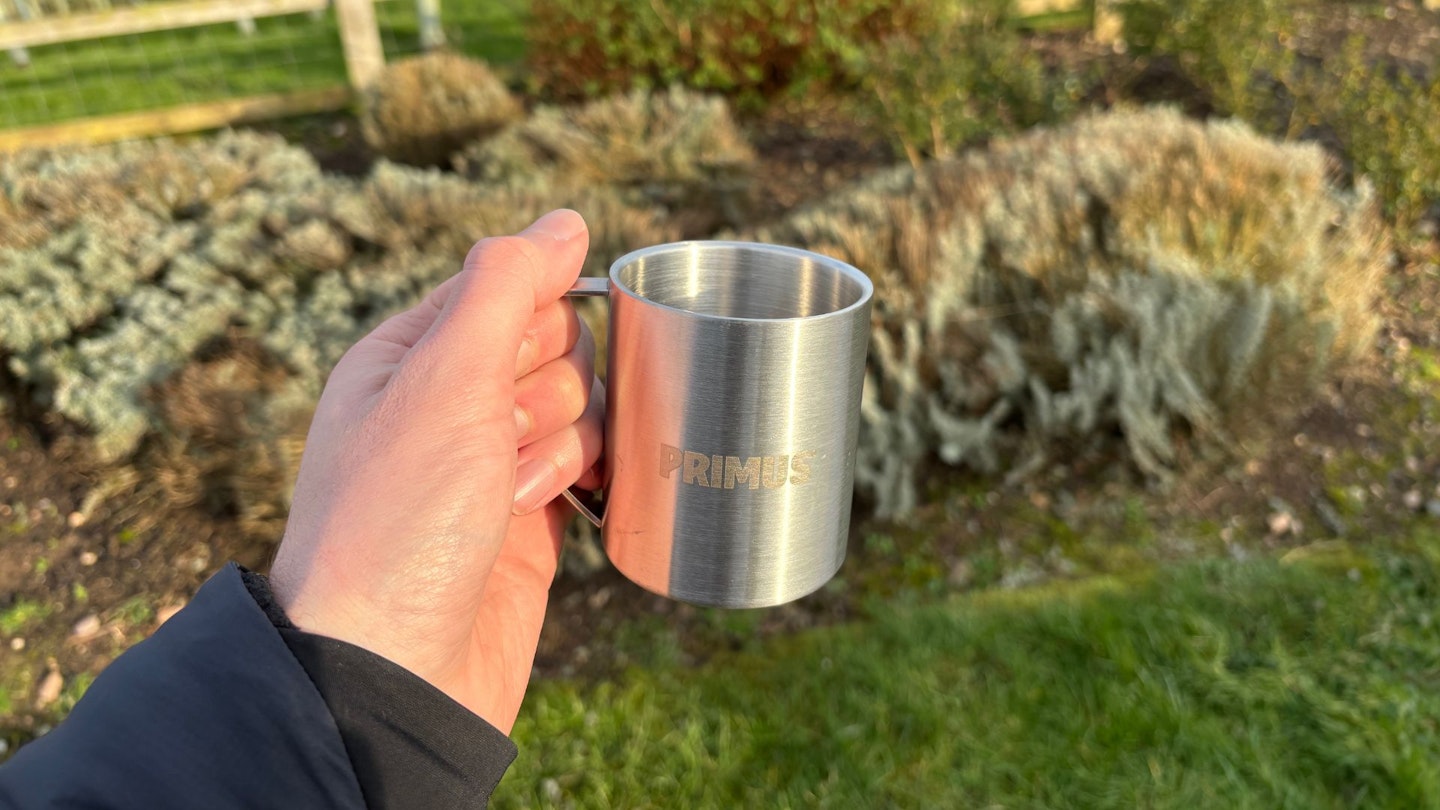 LFTO/Rob Slade
LFTO/Rob Sladeprimusuk.avln.me
It’ll come as no surprise that this was the lightest non-metal mug on test (130g), given the fact that it’s rather small and only has a 200ml capacity (you can also get a 300ml option).
It’s also the only mug here that doesn’t have a lid, so you’re probably assuming that this mug saw the biggest drop-off in temperature during our thermal tests.
Well, you’d be right. Ten minutes into the test the water temperature had dropped to 54°C, while it was down to 36°C after 30 minutes, 23°C after an hour and 14°C by the end of the test after two hours.
Of course, with a 200ml capacity, in all likelihood you’ll have polished this drink off much quicker than that.
It fared better in the ice cube test. While the ice cubes melted away within two hours and 30 minutes, three other mugs performed worse.
Durability is decent thanks to the stainless steel construction and the lack of lid or any other component makes this incredibly easy to clean. An RRP of £11 is also substantially cheaper than many other mugs featured here.
With no lid, it feels like you’re effectively drinking from a normal mug, but this does mean there’s no splash proofing to help you out if you’re drinking while on the move.
While good value, the things that let this mug down is that there’s not a huge capacity and you’re drinks cool down quicker than anything else in this list. But, if you need something lightweight for backpacking trips, it’s a reasonable option.
Pros
- Lightweight and packable
- Easy to clean
- Pretty durable
Cons
- Limited capacity
- Least thermally efficient on test
| RRP: | £11 / $12.95 |
| Weight: | 130g / 4.6oz |
| Material: | Double-walled stainless steel |
| Volume: | 200ml / 7oz |
| Dishwasher safe? | Not stated |
Stanley’s range of drinkware shot into the limelight in recent times after going viral on social media, but the brand’s heritage is still on show here.
It feels sturdy and well built, with minimal to go wrong. The lid has no sliding mechanism and instead just has a gap that’s always open for you to drink from.
That of course means it’s not leakproof. In fact, if you tip it on its side, water will dribble out from all angles. The lid is still a good barrier to splashes while moving about, though.
Drinking from it was often great, but on a semi-regular basis a bubble would form over the opening, temporarily blocking the steady flow of liquid. This typically resulted with the bubble bursting and more tea than wanted flowing out – not ideal if the drink is piping hot.
This could be avoided with care, and did happen with a few other mugs, too, but it’s a negative worth noting.
One of the benefits of the lid being designed as it is, is that it’s easy to clean and there are no nooks and crannies where grime can get stuck. And in more good news, the whole thing is dishwasher safe, too.
Moving on, in line with the other similarly styled mugs in this test, the Stanley Classic Legendary Camp Mug did a good job of keeping my drink warm.
After 10 minutes the temperature had dropped to just 68°C. It was 57°C after 30 minutes, 45°C after an hour and 34°C after two hours. That last result puts it in fifth for thermal efficiency, but there’s only a couple of degrees difference between the mugs in third and fourth.
It was the second-best performer in the ice cube test, with 15g of ice leftover after two hours.
On my scales the mug weighs in at 293g, which is lighter than several other comparable options in this test. Understandably, it doesn’t compete with some of the plastic options here on this front, but I think it’s a solid result and it doesn’t feel heavy in any way.
On a final note, I didn’t find the handle the most ergonomic, as the angles of the edges were fairly harsh to hold.
Pros
- Good heat retention
- Works well for cold drinks, too
- Easy to clean
Cons
- Flow rate of drink can be iffy
| RRP: | £31 / $23 |
| Weight: | 293g / 10.3oz |
| Material: | Double walled stainless steel |
| Volume: | 354ml / 12oz |
| Dishwasher safe? | Yes |
Yeti Rambler 14 oz (414ml) Stackable Mug
Yeti is a trendy brand and its products are often well-built. So it should come as no surprise that it’s also an expensive brand, hence the £31 RRP here.
Weight is one of this camping mug’s weaknesses and it’s immediately apparent when you pick it up. It comes in at 456g, making it the heaviest on test. Fill its 414ml capacity with a drink and it’ll be pushing up toward a kilogram.
The handle feels ergonomic, comfortable and allows you to get a stable grip, at least.
While the lid normally allows a steady, controlled flow of liquid, it can be prone to the odd bubbling effect that we’ve mentioned on a couple of other mugs, which can interfere with the flow, though it hasn’t caused too many issues.
My other small issue with the lid is that it can be a bit of a pain reach all the various ridges, channels and gaps to clean properly, particularly around the seal. The sliding mechanism is easy to pull off and get under (it's magnetic) and it is dishwasher safe, which will make a lot of people happy.
Staying with the lid, it’s not entirely leakproof, as liquid does dribble out when the mug is turned upside down, but it’s more than adequate for avoiding substantial spillages in the tent or when on the move.
When testing the mugs’ thermal properties the Yeti performed well. After 10 minutes sitting outside the water was still 69°C. After 30 minutes it was 58°C, it was 47°C after an hour and 35°C after two.
That final measurement meant the Yeti Rambler was the fourth warmest after two hours and it’s fair to say your drink will stay plenty warm enough until you’ve finished.
The mug proved fifth best at keeping things cool during our ice cube test and after three hours there was still 8g of ice left inside.
Pros
- Great thermal performance
- Solid and durable
- Comfortable handle
- Dishwasher safe
Cons
- Heaviest mug on test
- A lot to pay for a mug
| RRP: | £30 / $30 |
| Weight: | 456g / 16.1oz |
| Material: | Double-walled stainless steel |
| Volume: | 414ml / 14oz |
| Dishwasher safe? | Yes |
The second entry into this test from Primus is another small-capacity option, though this time there’s a capacity of 300ml. It’s a double-walled stainless steel construction, but the mug’s performance in our thermal tests were actually on par with the plastic options featured here.
In our cold test, this was the first mug to see the ice cubes melt completely.
In our heat test, performance was similarly disappointing. I will caveat that, though. While the drop off in temperature over two hours was surprisingly steep, it was less aggressive over the first 30 minutes, within which, in reality, you’ll probably be polishing off that 300ml of fluid.
How does this look in numbers? Well after 10 minutes the temperature was down to 65°C, after 30 minutes it was 49°C, after an hour it was 33°C and after two it was 19°C.
In use, drinks flow slowly from the opening in the lid, so there’s no risk of taking on too much and burning yourself. I didn’t notice any additional leakage from around the edge, either.
The mug feels durable, but I didn’t find the handle as ergonomic as some others in test, while the narrow nature of the mug means it’s going to be easier to knock over than some of the stumpier options here.
The Koppen is one of the smallest mugs here and the weight aligns with that, coming in at 219g. It’s easy to clean, too, which is a bonus, as it’s not recommended for dishwashers.
Pros
- Decently lightweight
- Lid offers steady flow when drinking
- Easy to wash
Cons
- Narrow build isn't the most stable
- Not the most thermally efficient
| RRP: | £23 |
| Weight: | 219g / 7.7oz |
| Material: | Double-walled, powder-coated stainless steel |
| Volume: | 300ml / 10.6oz |
| Dishwasher safe? | No |
 LFTO/Rob Slade
LFTO/Rob SladeThe Passage Insulated Mug is one of two plastic mugs featured in this test, so you’d be right in assuming it’ll be one of the lightest. The mug and lid weigh in at just 115g, while offering a capacity of 475ml. Only the GSI mug is lighter.
Given the plastic nature, the mug didn’t perform as impressively in our thermal tests as many of the metal options in this list. In the cold test, the ice cubes melted the second quickest, in around two hours.
Heat retention also scored low compared to many others, with the water temperature dropping to 17°C by the end of the two-hour test (the second lowest on test). After 10 minutes it had hit 59°C, after 30 minutes it was 43°C and after an hour it was 28°C.
When firmly wedged into the top of the mug, the lid offers a reliable splashproof cover, though inevitably it’s not leakproof given there are two permanently open holes.
I didn’t get on so well with the opening when drinking, as occasionally a bubble would form, interrupting the flow of tea/coffee. There’s only a small opening, so there’s a low risk of burning yourself when the drink pops through the bubble.
However, the inconsistent flow rate proved a bit of an annoyance.
The material feels durable, is BPA free and you can chuck the whole thing in a dishwasher, so it’s super easy to clean. There’s no handle (making it easier to pack), but the ribbed outer surface offers a decent amount of grip.
Pros
- Great value
- Lightweight
- Easy to clean
Cons
- Not the greatest to drink from
| RRP: | £14 / $19.95 |
| Weight: | 115g / 4.1oz |
| Material: | BPA free food-grade plastic |
| Volume: | 475ml / 16.7oz |
| Dishwasher safe? | Yes |
How to pick a camping mug
Lid
Two things must be true for something to be considered one of the very best camping mugs. One, that the lid doesn’t leak when you’re drinking from it or carrying it around. And two, that it’s easy to drink from.
Let’s look at that first point in more detail. We’re not expecting camping mugs to be entirely leakproof, as you’re rarely ever going to fill it up and chuck it into your rucksack (you’ll want an insulated flask for that), but we do need to avoid a situation where the drink is sloshing out of the mug when you move.
On point two, we want a steady flow of fluid from the lid without any surprises. That means no leakage from secondary holes and no changes in the flow rate while drinking.
Weight
If you’re car camping, weight isn’t so important. That being said, you won’t want a mug that’s so heavy it starts to make your arm ache, especially if kids are going to be using it, too.
Of course, if you need a mug to carry with you on a multi-day hike, weight is really important. The less you have to carry the easier the hiking will be, particularly when going uphill!
In these circumstances, you may need to sacrifice some other desirable aspects in order to keep the weight down. A giant Yeti mug might delight you because of how much coffee it can hold, but it’s not going to be ideal for a end-to-end hike along the Pennine Way.
Thermal properties
When you buy a camping mug, you’re doing so because you want to enjoy a hot drink while sat outside your tent. That’s a lot harder to do when your hot drink is, well, cold.
Naturally, a mug’s ability to keep a drink warm is a key consideration when making a purchase. A brand might make a claim about the number of hours their product will keep your drink hot for, but this needs to be taken with a pinch of salt as much will depend on conditions.
Similarly, consider how long you actually need a drink to stay hot for. Don’t be blindsided by a big number if in all likelihood you’re actually going to finish your drink within 15 minutes anyway.
Handle comfort
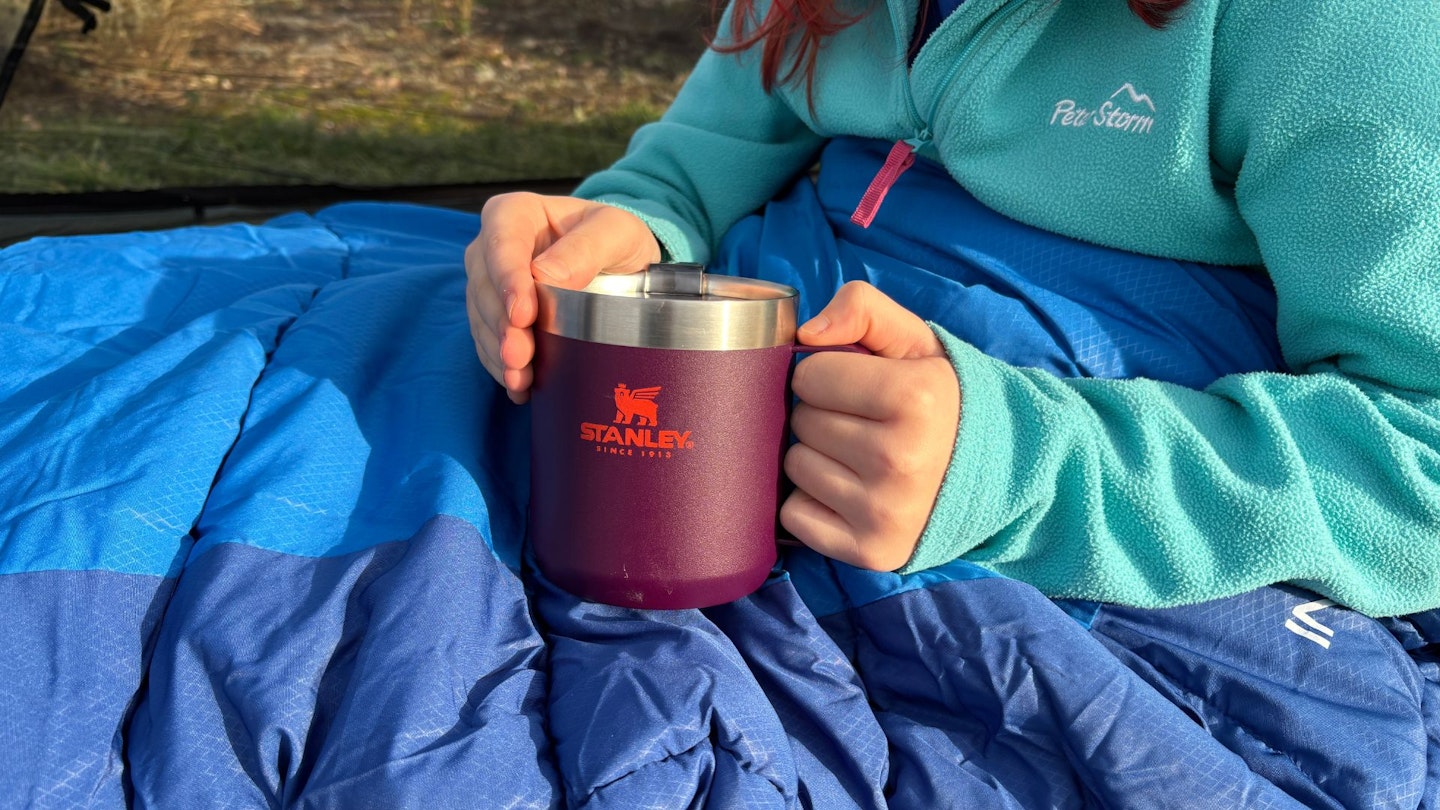
All handles are not created equal. Some may be rounded, while others may have harsher edges. Personal preference will inevitably come into play here, but it’s easy enough to point out something that’s particularly uncomfortable, which is not what you want when it’s fully loaded.
Handles also need to allow you to get a secure grip, too. The last thing you want is a slip and some scalding tea dropping onto your lap.
Capacity
There’s going to be an element of personal preference here. Camping mugs typically range from a capacity of 200ml up to (and beyond) one litre. The smaller they are, the lighter they’ll be.
Keep in mind that if you fill a mug with one litre of tea, that’s going to weigh one kilogram, plus the weight of the mug. So consider if that’s really want you want to be holding onto.
Washing
No one likes washing up, do they? Being able to chuck a camping mug into a dishwasher is likely to make a lot of campers very happy, but not all of them will be dishwasher safe.
If you are washing by hand, either at home or at the campsite, the easier it is to clean, the better. Lids can be hard to wash at times, depending on their design, so definitely keep that in mind when shopping.
Durability
Things get dropped and squished all the time while going camping, so it’s important that your camping mug is rugged enough to survive a bit of rough and tumble.
By their nature many of them are fairly durable by default as they’re made of medal, but the lids can be a weak point in the construction, so take a look at what it’s made of and how many moving parts there may be.
Rubber patches on the base not only help make your mug non-slip, but they can also help protect it from bumps and scrapes.
Meanwhile, plastic options will be lighter but are likely to be more prone to cracking when being jammed into your car with everything else you need to squeeze in.
About the author

Deputy editor Rob Slade has been hiking and camping for over half of his life, with more than a decade of gear testing under his belt. Along the way, he's camped out on the side of mountains, in the desert of Jordan and all around New Zealand for a period of four weeks.
Given that, it's fair to say he knows a thing or two about what makes a good product. Those that know him well will be shocked to see his name on this article, as he never really liked tea or coffee. But, ever eager to not look like a child in meetings (hello hot chocolate with whipped cream and marshmallows), he's taken up green tea in recent times.





